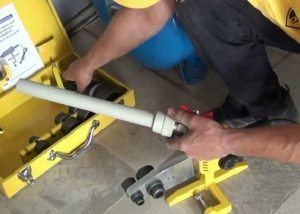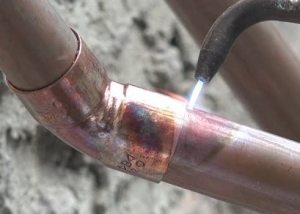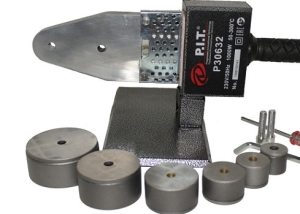The use of copper pipes allows you to arrange an effective and durable heating system or water supply. The simplest and most common way to connect such products is soldering technology. It assumes the presence of solder - a thermoplastic substance that provides sealing of the joint by melting and flowing under the action of high temperature. After cooling, it hardens and fixes the connection.
Content
Copper pipe preparation
These products are durable, durable, withstand high pressure and temperature, and are not afraid of ultraviolet radiation.
To solder copper pipes, you will need a pipe cutter, an expander, a hammer, a tape measure and a chamfer. The choice of pipe cutter is determined by the diameter of the products used. It allows you to get an even cut, which is perpendicular to the axis of the pipe. Chamfers are used to remove burrs and chamfers from product edges. Deburring the outer and inner edges of the pipes makes it easier to stick them into each other. Chamfers are in a round case (with a pipe diameter limit of 3.6 cm) or in the form of a pencil.
If the connection of copper pipes does not involve the use of fittingsthen a pipe expander is used.
Important! The expandable copper product must be either soft or annealed.
There should not be any flammable or combustible substances in the soldering room of the copper pipe. It is also necessary to provide good ventilation and ventilation.

For a good connection, an even cut is important, so the pipe must be cut with a special device - a pipe cutter
Materials required for work
Soldering of copper pipes can be done independently. To work, you will need:
- solder;
- steel brush;
- flux;
- brush;
- soldering iron or gas burner.
The solder has the form of a wire with a melting point lower than that of copper. This allows you to connect products by heating. Using a steel brush during the preparatory work, the inner surface of the fitting and the outer part of the pipe are cleaned.
The solder is high temperature, which is a thin copper wire with the addition of up to 6% phosphorus and having a melting point of 600-800 ° C, and low temperature - of tin, melting at 300-400 ° C.
Liquid flux is applied to the coupling and pipe until the assembly of the connecting unit, solid - is melted in the soldering zone. The paste flux is a thickened mixture that can be applied both before and after the joining process. The flux cleans the pipe surface from oxides, protects the soldering site from oxygen, promotes the spreading of solder and improves the adhesion of the parts to be joined.
There are gas burners with a stationary cylinder or disposable. There is a separate type of burner - acetylene-oxygen, which differ in their design. Power selection soldering apparatus carried out by the melting point of the solder. Professional tools solder copper pipes, semi-professional - hard and soft solder.
Features of solders and fluxes
There are a large number of hard and soft solders that can provide high-quality soldering of copper pipes. Low-temperature solders give a seam with somewhat worse mechanical parameters, but allow you to perform work at a temperature that does not have a strong effect on the strength of the pipe metal. About 95-97% of such solders is tin, the rest is other elements.
The best technological properties of compounds containing silver. There are three-component solders, which include tin, silver, copper. Fluxes used for brazing often contain zinc chloride.
Sufficient joint strength when soldering with soft solder is achieved by a large contact area of the elements. For gas pipelines, only high-temperature soldering is used, providing the best strength and reliability.
The permissible pressure in the pipelines when using different types of soldering is shown in the table.
Table 1
| Type of soldering | The temperature of the medium that is transported, ° C | Pressure, atm |
| Low temperature | 30 | 16 |
| 65 | 10 | |
| 110 | 6 | |
| High temperature | 30 | 40 |
| 65 | 25 | |
| 110 | 16 |
For high temperature brazing, copper-phosphorus solders are usually used. They are available in the form of rods.
Note! Copper-phosphorus solder can not be used when soldering cast iron, steel, as well as non-ferrous metals, which include more than 10% nickel.
The use of flux and solder from the same manufacturer for both low and high temperature brazing is recommended.
Soft soldering
Low-temperature soldering is used when installing water and heating networks with a coolant temperature of up to 130 ° C and a pipe diameter of up to 10 cm.
The technology of joining copper products with soft solder involves preliminary cleaning of the surfaces, applying a flux paste with a brush and inserting elements into each other. Further, the junction is heated by a gas burner up to 200-250 degrees. Solder is applied to the edge of the joint.
During soldering, it is important to remember that the temperature of the burner flame can reach 1 thousand degrees, so 15-20 seconds are enough to warm up the elements. For uniform heating, the flame must be constantly moved. The degree of heating is controlled by the color of the flux. After darkening it is necessary to take solder.
After the introduction of soft solder into the soldering zone, in contact with a heated copper pipe, the tin wire begins to melt and slide along the flux into the seam. Gradually heated mass fills the space between the bell and the pipe.
Brazing
Do-it-yourself soldering of copper pipes using solid solder is carried out if the system is planned to be operated at temperatures above 110 ° C. For the connection, a temperature above 700 degrees is necessary, therefore, the soldering is performed in a gas-flame way.

Copper-phosphorus solder is available in the form of rods and is used for high-temperature soldering
Note! Brazing technology involves annealing of metal, which leads to softening of copper.
The use of copper-phosphorus solder does not require flux. If you correctly ensure uniform heating of the ends of the products, then it will fill the gap. The readiness of the connection is checked by a solder bar - it should melt.
The soldering steps are as follows:
- The docking station is assembled and warmed up.
- At the junction of the socket and the pipe, solder is introduced, which is softened by the burner.
- After the first clutch, the pipe is rotated and the softened solder is wound onto the subsequent joint section.
The advantages of brazing technology for copper pipes are:
- good seam strength;
- the ability to reduce the width of the connection;
- applicability in systems operating at high temperature.
Since the proper brazing of copper pipes should exclude overheating of products, which leads to ruptures, it is better to entrust the execution of work to specialists.
The main mistakes when soldering do it yourself
Before you solder copper pipes, you need to make sure that there are no defects on their surface that often appear when cutting products. The reliability of the seam largely depends on the purity of the materials used in the work. For pipes with a diameter of 6-108 mm, the width of the resulting compound can be 7-50 mm.
Important! With insufficient heating of the copper pipe or solder, the tin or copper wire of the latter will not stick to the flux and will not soften. This will lead to leakage at the junction.
Sometimes when applying flux, some sections of the pipe are skipped, which entails poor adhesion of the solder to the product. Overheating of the pipe leads to a similar result, in which the flux burns out.
During soldering, it is important to comply with safety requirements, since work involves the use of an open flame and chemically active substances. Before soldering copper pipes, it is necessary to take care of personal protective equipment: mittens, glasses, etc.
Properly organized and completed connection work copper pipes will provide a long service life of the pipeline.










